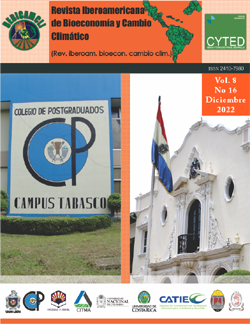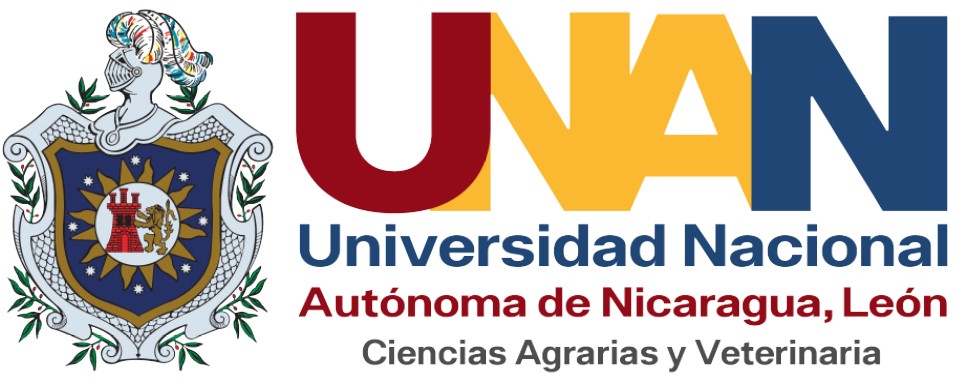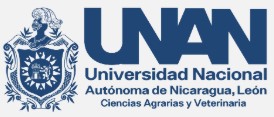Stimulating Tropical Soils with Na+ Cl- Radicals and Reclamation of Na+ Cl- Salinity Using Biochar and Hydro-Leaching Technology: A Sustainable Strategy for Management of Saline and Sodic Soils Under Climate Change
DOI:
https://doi.org/10.5377/ribcc.v8i16.15015Keywords:
Salt-affected soil, Biotechnical Tools, Hydro-leachingTechnology, Biochar Technology, Clean MechanismAbstract
Humanity suffered far-more-than 80% increase in environmental-climatic-ecosystem-degradation. As a modality towards sustainable-solution to salt-soil toxicity with climate-change, and for the reclamation/management of global Salt Affected-Soils, this study investigated soil-salinity status with the objectives of x-raying sustainable approaches for the management and reclamation of salt-affected soils. Stimulations and laboratory studies were conducted to induce soil samples with 70g of Na+Cl- radicals which follow a reclamation procedure with 70 g of biochar technology and leaching with one (1) liter of distilling water. Results indicated the two reclamation strategies were able to reclaim soils induced with inducing Na+Cl- radicals at a Coefficient of Variation value at (CV=62%) which indicated a high variability potential in the reclamation technology. Forecasting results indicated that the area could remain free of salt, but if unsustainable practices like the application of untreated wastewater for irrigation, then a percentage at a high dosage of salt (4.3 dS/m for Na+Cl-) could result as observed during the inducement stage of this experiment. Biotechnical tools like Biochar at 70g are recommended for reclamation at a pot stage of salinity influence, and at a larger dosage for larger fields, as this could drive sustainable soil-productivity.
Downloads
Metrics
References
Abel G. J, Brottrager M, Crespo Cuaresma J, Muttarak R (2019). Climate, conflict and forced migration. Global Environmental Change, 12:3-5. [pure.iiasa.ac.at/15684] https://doi.org/10.1016/j.gloenvcha
Adiaha, M. S., Chude, V. O. ., Nwaka, G. I. C. ., & Oku, E. E. . (2022). Carbon auditing in tree-soil nexus: a sustainable approach towards CO2 sequestration and environmental transformation. EQA-International Journal of Environmental Quality, 48 (1), 1–9. https://doi.org/10.6092/issn.2281-4485/13838
Adiaha M.S., Chude V.O., Nwaka G.I.C., Oku E.E., Ojimiwe K.O. (2021) Carbon and man in the 21st Century: trees as a tool for climate manipulation towards a sustainable environment. Colloquia Series of the Proceedings of the 4th Conference of Soil Science Society of Nigeria (SSSN), Colloquia SSSN 44:380-387.
Adiaha, M. S., Buba, A. H., Tangban, E. E, & Okpoho, A. N. (2020) Mitigating Global Greenhouse Gas Emission: The Role of Trees as a Clean Mechanism For CO2 Sequestration, The Journal of Agricultural Sciences, 15:1, 101-115. Retrieved from: http://doi.org/10.4038/jas.v15i1.8675
Alhassan, M., E. Mesaiyete and A.M. Mustapha. (2012). Clay mineralogy of lateritic soils derived from granite basement-a case study of Minna lateritic soils. J. Geotechn. Engg. 17: 1897-1903.
Burke, W. and L.E. Sommers. (1986). Soil structure assessment. Balkema A. A. Rotterdam.
Bennett, A. F., & Ruben, J. A. (1979). Endothermy and activity in vertebrates. Science, 206(4419), 649-654.
Balogun, O. (2001). The federal capital territory of Nigeria: Geography of its Development. University of Ibadan; University of Ibadan Press. Nigeria.
Bernstein, L. (1975). Effect of Salinity and Sodicity on Plant Growth. Agricultural Research. United State of America Department of Agriculture. 295-3624.
Capetillo-Burela, A., López-Collado, C. J., Zetina-Lezama, R., Reynolds-Chávez, M. A., Matilde-Hernández, C., Cadena-Zapata, M., & López-López, J. A. (2021). Conceptual model of nitrogen fertilization for corn (Zea mays L.) in Veracruz, Mexico. Rev. Iberoam. Bioecon. Cambio Clim., 7(14), 1617–1631. https://doi.org/10.5377/ribcc.v7i14.12606
Capetillo-Burela, A., Zetina-Lezama, R., Reynolds-Chávez, M. A., Cadena-Zapata, M., López-López, J. A., Matilde-Hernández, C., & Espinoza del Carmen, A. (2021). Elaboration of paper with six varieties of pennisetum purpureum schumach in Veracruz, Mexico. Rev. Iberoam. Bioecon. Cambio Clim., 7(14), 1674–1696. https://doi.org/10.5377/ribcc.v7i14.12608
Catari Yujra, G., Guzman-Moreno, M. A., Hands, M., & Reyes-Osornio, M. (2022). Yield of Maize Alley Cropped with Inga Trees and Several Levels of Natural Fertilizers. Rev. Iberoam. Bioecon. Cambio Clim., 8(15), 1886–1897. https://doi.org/10.5377/ribcc.v8i15.14383
Colon-García, A. P., Catari-Yujra, G., & Alvarado, E. (2021). The productive paths of the bioeconomy: The case of Honduras. Rev. Iberoam. Bioecon. Cambio Clim., 7(14), 1713–1726. https://doi.org/10.5377/ribcc.v7i14.12820
Chude, V., Oku, E., Nwaka, G., & Adiaha, M. (2020). Soil compaction assessment as a manipulative strategy to improve soil biodiversity: an approach for meeting SDG two and six. Land Reclamation and Water Management, (1), 131 - 143. https://doi.org/10.31073/mivg202001-224
Danielson, R.E. and P.L. Sutherland. (1986). Methods of soil analysis. Porosity. In: Klute, A. (ed.). 2nd edition. Madison: American Society of Agronomy. 1: 443-461.
Francious, L. E and Maas, E. V. (1994). Crop response and management of salt affected soils/ Pessarakle M. (ed.) Handbook of plant and crop stress – New York, USA
FAO (2017). Saline Soils and Their Management. Https://Www.Fao.Org/3/X5871e/X5871e04.Htm (Retrieved 13/11/2021)
FA0 (2016). The State of Food and Agriculture 2016. http://www.fao.org/3/a-i6030e.pdf (Retrieved 13/11/2021).
FAO (2020). Migration, Agriculture and Climate Change: Reducing Vulnerabilities and Enhancing Resilience https://www.fao.org/emergencies/resources/documents/resources-detail/en/c/1106745/ (Retrieved 13/11/2021).
FAO (2021) State of knowledge of soil biodiversity – Status, challenges and potentialities https://www.fao.org/3/cb1928en/CB1928EN.pdf (Retrieved 13/11/2021).
FAO. (1963). High dams soil survey project. Deb. BC. Rome.
García Hernández, M., Pérez Magaña, A., Martínez Corona, B., & Gutiérrez Villalpando, V. (2020). Change of soil use and climate variability in Chiautzingo, Puebla, Mexico. Rev. Iberoam. Bioecon. Cambio Clim., 6(11), 1295–1315. https://doi.org/10.5377/ribcc.v6i11.9421
Gee, G.W. and J.W. Bauder. (1986). Particle-size Analysis. p 383-411 In A. Klute (ed.) Methods of Soil Analysis Part 1. Soil Science Society of America Book Series 5, Madison, Wisconsin, USA.
Government of New South Wales Department of Agriculture, NSW Agriculture (2003). http://www.dpi.nsw.gov.au/__data/assets/pdf_file/0008/519632/Salinity-training-manual.pdf (Retrieved 13/11/2021).
Hayward, H.E. (1954). Saline and alkali soils -- Their diagnosis and improvement. Soil Conservation. 20:75-81. U.S. Salinity Laboratory-United States Department of Agriculture, Publication ID number 188. https://www.ussl.ars.usda.gov/pubinfo.aspx?id=188
IPCC, (2016). Intergovernmental Panel on Climate Change. www.ipccglobalannualreport . (Retrieved 31/6/2019).
International Institute of Applied System Analysis (2019) New study establishes causal link between climate, conflict, and migration. https://iiasa.ac.at/web/home/about/news/190123-migration-climate.html (Rederived 28/11/2021)
Ishaya, S., (2013). Flood Vulnerability Mapping in Gwagwalada Urban Area, Abuja, Nigeria. Unpublished Master’s Thesis, Department of Geography, University of Abuja, Nigeria.
Kachinskii, N. A. (1970). Soil physics p. I Mir Publisher. In S. V. Zonn, (1986). Tropical and subtropical soil science. Mir Publisher, Moscow.
Jeffrey L.U. (2013) Strategies for Minimizing Salinity Problems and Optimizing Crop Production, Agricultural & Biological Engineering: In-Service Training, Manual, Hastings, FL. University of Florida. https://hos.ifas.ufl.edu/media/hosifasufledu/documents/IST30688---7.pdf (Rederived 28/11/2021)
Lin, Z.Q and Bañuelos G.S. (2015) Soil Salinization Indicators. In: Armon R., Hänninen O. (eds) Environmental Indicators, Springer, Dordrecht. https://doi.org/10.1007/978-94-017-9499-2_20
Landeros-Sánchez, C., Moreno-Seceña, J. C., Castañeda-Cháves, M. del R., Lango-Reynoso, F., Hernández-Pérez, J. M., Hernádez-Lara, O., & Caballero-Hernandez, A. J. (2016). Handling of nitrogen in the sugar zone center of Veracruz, México. Rev. Iberoam. Bioecon. Cambio Clim., 2(1), 43–52. https://doi.org/10.5377/ribcc.v2i1.5677
Lawal, B.A., M.K.A. Adeboye, P.A. Tsado, M. Elebiyo and C.R. Nwajoku, 2012. Properties, classification and agricultural potentials of lateritic soils of Minna in sub-humid agroecological zone, Nigeria. Int. J. Devel. Sustain. 1(3): 903-911
Liang Y, Si J, Nikolic M, Peng Y, Chen W, et al. (2005) Organic manure stimulates biological activity and barley growth in soil subject to secondary salinization. Soil Biol Biochem 37: 1185–1195.
Natural Resources Conservation Service, NRC of USDA (2015). Soil Water Characteristics.
Oku, E.E., S.A. Emmanuel, N.C. Odoh and B.I. Musa. (2020). Soil physical fertility status and management prescription for soil sustaining farms and ranches in Abuja, Nigeria. Journal of Environmental and Agricultural Sciences. 22(1):57-63.
Odeh, O. A. and Onus, A. E. (2008). Spatial Analysis of Soil Salinity and Soil Structural Stability in a Semiarid Region of New South Wales, Australia. Environmental Management (2008) 42:265–278. https://doi.org/10.1007/s00267-008-9100-z
Ojanuga, A.G. (2006) Agroecological Zones of Nigeria Manual. In: Berding, F. and Chude, V.O., Eds., National Special Programme for Food Security (NSPFS) and FAO, 124.
Pannell, D. J. and Ewing, M. A (2006) Managing secondary dryland salinity: options and challenges. Agric Water Manage 80: 41–56.
Pagliai, M. (1988). Soil Porosity and soil Hydrology Aspects. International Agrophysics, 4: 215-232.
Pla, I., (2007). Soil degradation and desertification: New approaches. p. 17-36. In A. Rodriguez and C. Arvelo (ed.). Control of soil degradation and desertification. University of La Laguna, La Laguna (Spain).
Todman1, L.C., Chhang, A., Riordan, H. J., Brooks, D., Butler, A. P., and Templeton, M. R. (2018). Soil Osmotic Potential and Its Effect on Vapor Flow from a Pervaporative Irrigation Membrane. J. Environ. Eng., 144(7): 04018048
Úbeda Rivera, J. S., & Delgado Dallatorre, Y. (2018). The infiltration of water into the soils and artificial components and organic matter that are used in them for agriculture. Rev. Iberoam. Bioecon. Cambio Clim., 4(7), 889–896. https://doi.org/10.5377/ribcc.v4i7.6299
Udo, E.J., T.O. Ibia, J.A. Ogunwale, A.O. Ano, and I. E. Esu. (2009). Manual of soil, plant and water analysis. Lagos: Sibon Books Publishers Limited., Nigeria.p: 183.
USDA-United States Department of Agriculture, (2013) Technical References on Soil Water Characteristics and SPAW. USDA, pp 34.
Vijayvargiya, S. and Kumar, A. (2011). Influence of Salinity Stress on Plant Growth and Productivity: Salinity stress influences on plant growth. Germany. Lap Lambert Academic Publishers.170 pp.
Published
How to Cite
License
Copyright (c) 2022 Rev. iberoam. bioecon. cambio clim.

This work is licensed under a Creative Commons Attribution-NonCommercial-ShareAlike 4.0 International License.
Copyright © 2025 Rev. iberoam. bioecon. climate change. National Autonomous University of Nicaragua León (UNAN-León), Knowledge Area of Agrarian and Veterinary Sciences / Specific Area of Agroecology and Agribusiness / Center for Research in Agrarian Sciencies. Academic Directorate. Research Department. Publication and scientific events Unit.












 EDITORIAL
EDITORIAL e-ISSN
e-ISSN


 COPYRIGHT
COPYRIGHT This work is licensed under a Licencia Internacional
This work is licensed under a Licencia Internacional 












